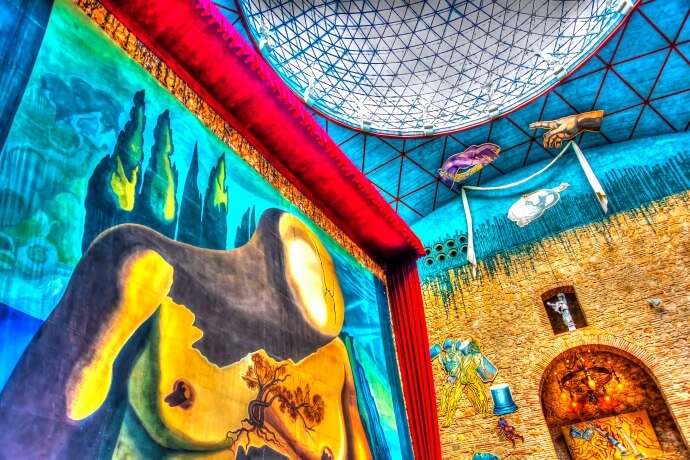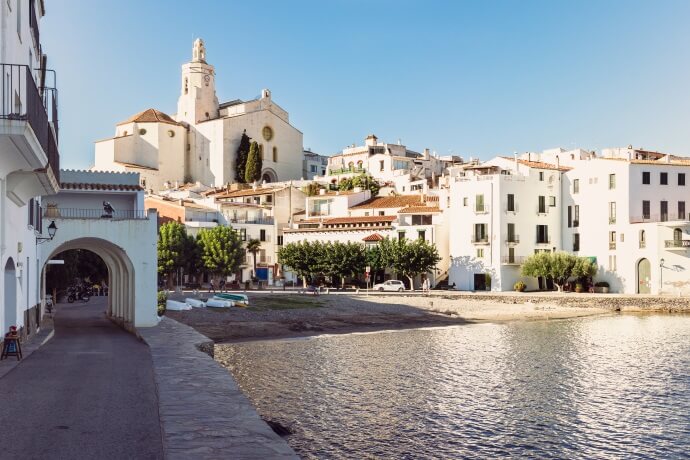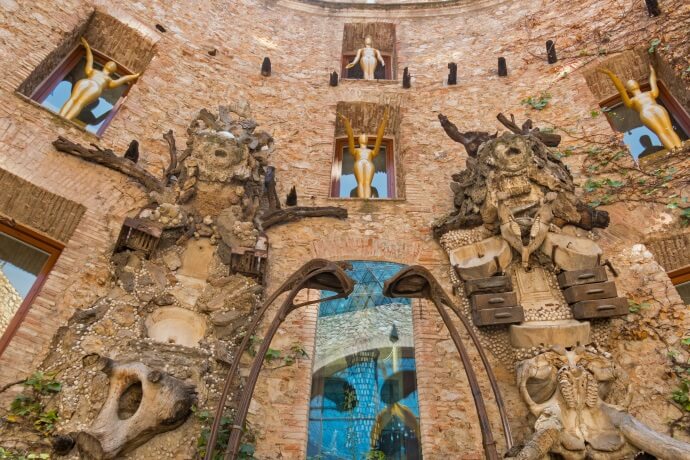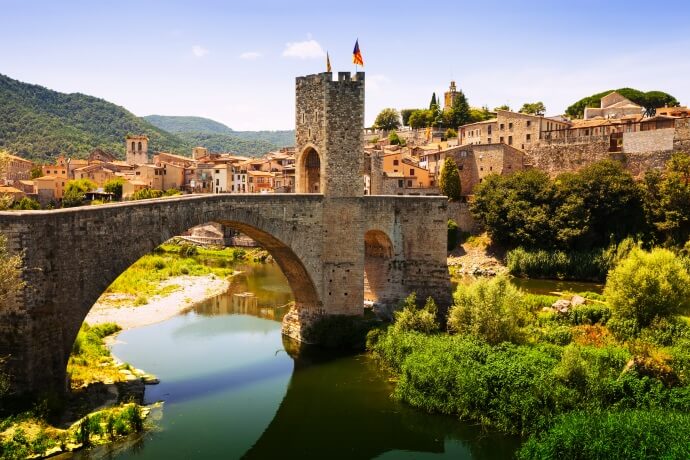When we like an artist and we end up visiting a location somehow related to his life, very often we find ourselves picturing in our head his life, his words, his mannerisms and wondering in what way that place influenced the work of the artist we admire. We create a film in our heads of how the person must have lived to try to explain the reasons for their choices as an artist. Eventually we might even realize that we begin daydreaming and telling tales to ourselves, that is, creating our own story. And that is alright: we all do it!
The life of Catalan artist Salvador Dalí, who was born in the region of Costa Brava, in the province of Catalonia, in Spain, and who became internationally recognized, is an example of how the place and the environment you live in may have quite an influence in what you do later. And Dalí’s eccentric character is definitely one prone to the creation of stories around it!
Catalonia had, throughout its history, many disputes with the central government of Spain, as they considered themselves an independent region. Being a son of Costa Brava, in Girona, Catalonia, this spirit of independence and longing for freedom remained with Dalí for life and originated some of the most dramatic artwork he produced. Dalí was unconventional and a free spirit yet he was well rooted in his culture. He was a Costa Brava and Catalan through and through: a rebel with many questions, with an authentic and deeply honest soul.
Let us take you on a trip to Dalí’s world so you can take a sneak peek at what the artist’s life was. From here you will be able to understand better this incredible figure and maybe get inspiration to start building a fantasy world of your own while traveling in the footsteps of Dalí.
Who was Salvador Dalí?

Salvador Domingo Dalí Domènech (or just Dalí) was born in Figueres, in the region of Catalonia, in Spain, in 1904, and died in 1989, in the same town. He was a Spaniard painter and designer who stood out for his unusual and dream-like compositions. With his sinuous mustache and willingness to scandalize, he was a great representative of the "Surrealist Aesthetic."
Dalí immediately drew attention with attires that showed an offbeat appearance: long hair, disproportionately large ties, and a cape that went down to his feet. Since his young years, he made paintings that went from realism to cubist compositions. During his lifetime, he traveled to Paris, met with Picasso and became an official member of the Surrealist movement, led by poet André Breton, which emerged as a reaction to the rationalism and materialism of Western society. Using the potential of the subconscious as a source of fantastic images and dreams was the goal of the Surrealist group, and Dalí became a master in this.
Back in Spain he met Gala (Helena Ivanovna Diakonova), who came into his life after leaving the poet Paul Éluard and became his companion and model, some say his muse. Together they bought and transformed a house in the quaint fisherman’s beach of Port Lligat, in the town of Cadaqués, province of Girona, close to where he was born. Here they created a quirky love nest and creative studio with unique sea views.
In the 1930s, Dalí produced the best of his work: canvases in which people, animals, objects, and landscapes merged in unusual compositions providing a feeling of entering an alternative universe, or a “metaverse” as it is commonly known nowadays. The painter used to say: "The difference between me and the surrealists is that I am a surrealist”. Dalí made use of what he christened the "Paranoid-Critical Method" in an attempt to represent the flow of the unconscious and dreams. His strange dream images were depicted as clearly and realistically as possible in a mode of painting that resembled color photography.
Eventually, the writer André Breton expelled him from the Surrealist group and created an anagram with the artist's name to denounce his appetite for money: "Avida Dollars".
With the outbreak of World War II, Dalí took refuge in the United States with Gala, where they remained for eight years.
In the 1950s, Salvador Dalí began a phase inspired by masterpieces of past painters. Later, Dalí alternated painting with jewelry design and book illustrations. In 1974, the Dalí Museum was inaugurated in Figueres, and eight years later his great love Gala died, a fact that shook his artistic activity. Living a restless life that originated a permanently questioning (and questioned) art, Salvador Dalí died in Figueres on January 23, 1989.
Costa Brava is the place to go for all things Dalí!

A visit to Catalonia is the perfect opportunity to explore in Costa Brava more about Dalí and his creative genius.
Even though the region is most famous for being a popular summer destination, the fact is that its charm only increases during the rest of the year, when less crowds allow for a more relaxed pace discovering new cultural and historic sites under the mild fall or winter weather. Some of the places that Dalí visited and lived in are now part of well established, organized art itineraries, but you can actually do them independently throughout the year on a tour of Catalonia. Learn more about the artist who never conformed to the establishment by enjoying calmly the locations in the beautiful Costa Brava that somehow relate to him and to his work. It is like a perfect match between spectacular views and a great deal of cultural enrichment!
Figueres

Figueres is the capital of the municipality of Girona, in the Catalan region of Costa Brava, and the birthplace of Salvador Dalí. The town of Figueres is one of those very charming locations, where it is worth parking the car and walking through its medieval center, while observing the buildings and alleys and its incredibly well-preserved castle, the San Fernando Castle, considered the largest bastion fortress in Europe.
However, a visit to trace back the footsteps of Dalí must absolutely go through Figueres at some point and include a visit to the Dalí Theater and Museum. This masterpiece by Dalí was inaugurated in 1974, being built on the remains of the former Municipal Theatre of Figueres. The building is considered to be the last great work of Salvador Dalí. Every detail inside and even outside was conceived and designed by the artist, so as to offer visitors a real experience and draw them into his unique and captivating world. As if you were a fundamental part of this artwork!
Around the museum there are some very interesting sculptures, including one by Dalí himself. It is called Homage to Newton and it is a replica of the one inside the museum. Here you will definitely feel like you are stepping into an alternative universe!
Port Lligat and Cadaqués

Cadaqués is one of the most representative places on the Costa Brava. This is a stunning sea town with a rocky coast, edged by beautiful beaches and clear water bays. Its amazing ocean views together with the dramatic landscape offered by the Cap de Creus Natural Park are the main attraction of the region and a real feast for the eyes!
Dalí's house in Port Lligat by the beach with the same name, near Cadaqués’ historic center, brings us closer to the world and reality of the artist. With incredible views of the sea and a studio fit to an eccentric artistic genius, the house is a maze-like structure made out of a series of fishermen's cabins put together. This is one of the most pleasant parts of the itinerary that traces back the history related to Dalí: to walk through the beautiful nook where many of his works were conceived and painted will definitely get your imagination and creativity flowing.
Pubol and Begur

Pubol is a very small medieval town in which Dalí lived for a while in a castle! The artist purchased this impressive gothic fortress in the 60’s but had it transformed later following a plan by Dalí himself as he wanted it to serve as a mausoleum for his wife and muse Gala, when she passed away. Since 1996, the castle is open to the public and it is like an incredible “love letter” from Dalí to Gala in a last effort to preserve her memory and worth alive.
Travel to Begur to find the many turquoise water beaches of the region whose colors and hues inspired the artist so much in his work. Summer or winter, these are beautiful and completely worth any small detour.
Besalu

Besalú is a small village of 2,500 inhabitants in the province of Girona, west of the Costa Brava. It is a very easy drive for those traveling through the Girona and Costa Brava region. This former peasant village attracts many people every year due to the excellent state of conservation of its medieval art-historical complex, one of the best preserved in Catalonia and an authentic trip back to the Middle Ages.
The Spanish government recognized Besalú's importance in 1966, declaring the village a National Historic-Artistic Site. Besalú is a very beautiful village that stands out as a whole, and the best in Besalú is to get lost in the narrow, uneven streets and to wander through the village without a pre-defined itinerary.
We wanted to include this town in the route following Dalí’s footsteps because this is an excellent example of a well-preserved historic center with undamaged churches and other heritage so typical of Costa Brava, that you will immediately recognize similarities in the work of Dalí. Walking the old streets and admiring the archways or turrets of ancient Christian temples, you will see how it was easy for Dalí with such an imagination, to transpond that energy into his paintings. It is as if the region that saw him being born and grow up was made of the very material that dreams are made of.
Dalí and Costa Brava: un unbreakable link!
If you are a fan of the work of Salvador Dalí what we say is that Costa Brava will be anything but indifferent to you. The richness of its landscape, both inland and near the shore, the many hues of blue and green and the wealth of heritage that you will find in every town will provide for a very clear context to the sometimes-misunderstood genius. You will know that if someone is born in such a beautiful, magical region as this one, then one is likely to bear inside for life, a constant desire for a dream world where anything is possible.



